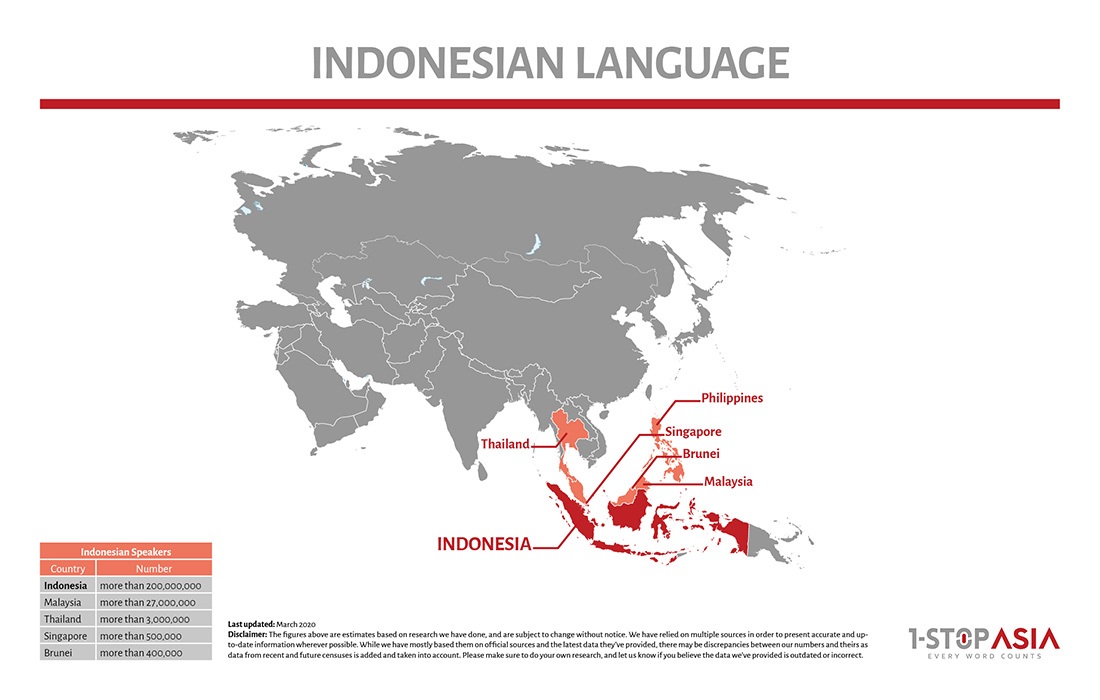Indonesian Language
199M Indonesian Speakers
Indonesian is very similar to Malaysian-also known as Bahasa Melayu-though it differs in spelling pronunciation and vocabulary.
Indonesia is the fourth most populated country in the world, and most of this population speaks Indonesian, making it one of the most widely spread languages.
Indonesian or Bahasa Indonesia is the official language of the multiple islands united under its name. When translating into Indonesian, it’s very important to keep in mind that the population of the archipelago consists of distinct ethnic, linguistic, and religious groups. Although Indonesian is taught in schools, each of these communities has its own views and opinions that need to be taken into consideration as part of the translation process.
The language is similar to Malay – also known as Bahasa Melayu – though it differs in spelling, pronunciation, and vocabulary.
If you feel it is time to improve your time-management and pay more attention to your clients
The complexity of Indonesian translation
1. The written language > Translation Service
- Vowels: There are six vowels in the Indonesian language which are shown in the table below. However, there are other existing analyses that set up a system with other vowels, particularly the open-mid vowels /ɛ/ and /ɔ/. In standard Indonesian orthography, the Latin alphabet is used, and divided into five vowels: a, i, u, e, o. In materials for learners, the mid-front vowel /e/ is sometimes represented with a diacritic as é to distinguish it from the mid-central vowel /ə/.
Front Central Back Close i u Close-mid e ə o Open-mid (ɛ) (ɔ) Open a - Diphthongs: There are four diphthongs, which are ‘ai, ‘au, ‘ei and ‘oi’. Almost all of the diphthongs are located at the end of the word. Only on some occasions, a diphthong is put in the middle of the word. The ai and au are pronounced [aɪ̯] and [aʊ̯] in the final position and as separated vowels, [a.i] and [a.u], elsewhere.
- Grammar: The basic Indonesian word order is similar to English. As a rule of thumb, it is in the order Subject + Verb + Object. The verbs are not changing depending on tense so, if you want to use past, present or future tense there are words that are added to indicate the time. In addition, one can emphasize certain words by changing the word order and placing them to gain attention.
- Names: Indonesian names are not generally separated into first and family names. A single name is recognized as a full name and the given name is additional. Until recently, most Indonesians did not have family names. Both men and women usually have a given name and take the name of their father as a family name.
2. The spoken language > Media Service
- Honorifics: In spoken Indonesian, it is very important to address everyone properly with the right title. If someonе is older than you, it is important to use the proper expression. For example, if you are speaking with an older man you must call him Pak, (From Bapak – Father) this is like calling someone Sir and it is rude if you don’t do that. The same is valid for talking to an older woman – you must address her as an Ibu (mother) or just Bu for short.
Over the last few years, besides Indonesians themselves, foreigners’ interest in learning the Indonesian language has grown. This trend reflects the fact that Indonesian business is booming, resulting in a higher demand for Indonesian translation. However, it can be a sensitive process and it’s essential to keep in mind that the population of Indonesia is a diverse mix of groups with distinct ethnic, linguistic, and religious features. Although Indonesian is built-in in their education, each community has its cultural specifics that need to be taken into consideration as part of the translation process.
Get exclusive insights into the world of translation, localization, and the language industry.
Our solution for you
Native translators with local knowledge
At 1-StopAsia we have regular access to native resources for the Indonesian language. Along with that our experienced teams of Project Managers are carefully trained to monitor your projects to minimize mistakes and misunderstandings. Our Quality Assurance process ensures that your translation is translated and reviewed by a team with specific experience on the subject-matter at hand. This process gives us one more chance to make sure all will go smoothly with the work you have trusted us.
25 years of experience
With over 2 decades of experience in this business, we’ve cultivated a team of highly experienced Project Managers who all possess an in-depth understanding of the industry, and most importantly, have access to a robust and agile project management system. They’re always there to handle your inquiries, save you time and deliver your translations within the time limit you’ve chosen to allow for each assignment.

